You know, I try to let philosophy prove its worth to me. I constantly recognize that, if so many people believe it’s useful, that maybe I’m the one that’s missing something. I don’t dismiss the contemporary philosophers without hearing what they have to say. Yet every time, this proves to be almost totally wasted effort. This latest example has demonstrated that philosophy relies on terms and ideas that really aren’t comprehended at all.
Richard Polt, who probably gets paid quite a lot for this, offered his take on a concept called reductionism in an opinion piece for the New York Times, Anything But Human. Reductionism, at least as applied in this circumstance, is the idea that humans are no more complex than the cells that make up our bodies, and if we understand the cells and their relations to each other, we understand how our minds work. The opposite idea of this is dualism (if you prefer, Cartesian Dualism,) which proposes that the mind is a separate function – consciousness, soul, transcendence, whatever – something more than just the cell interactions of the physical body. I need to keep something clear right from the start: philosophers are not biologists, so they’re not beholden to demonstrate just where or how dualism might arise; their only ‘duty’ (if they even promote the idea, which many don’t) is to show that there seems to be some difference.
Unfortunately, Polt falls down on three separate levels. The first is, he never bothers to try and understand the biological processes that govern our thinking processes, he simply assumes there isn’t any. Second, he does not take the time to fathom the numerous concepts, like ‘virtue’ and ‘altruism,’ that he throws around casually. But third and unforgivably, he resorts to some crass and juvenile mangling of concepts like ‘information’ and even ‘analogy’ to try and besmirch the argument he opposes. A little tip for someone who really should know better and cannot apparently be bothered to refer to a dictionary for words with which he’s unfamiliar: “Analogous” means, “like,” or “similar.” It does not mean, “perfect match,” or “equal to.”
Let’s tear into his points, because hidden within are some really interesting and valid avenues of examination. On a section regarding behavior and evolutionary selection (within, he’s quoting E.O. Wilson from a separate article):
Selection also operates between individuals: “within groups selfish individuals beat altruistic individuals, but groups of altruists beat groups of selfish individuals. Or, risking oversimplification, individual selection promoted sin, while group selection promoted virtue.” Wilson is cautious here, but some “evolutionary ethicists” don’t hesitate to claim that all we need in order to understand human virtue is the right explanation — whatever it may be — of how altruistic behavior evolved.
This isn’t exactly true, and it’s not clear whether Polt simply doesn’t understand why these are examined or thought his argument sounded better this way. The goal is to try and determine how altruism evolved, since by its very nature it puts the organism (e.g, human predecessor) at risk. How does one pass on a genetic tendency to get oneself killed? But virtue is perfectly understood by biologists, since overall it’s beneficial to a cooperative, social species. No mystery here. There is research into how exactly this develops in the brain, and whether or not this can fail and result in things like psychopathy; there is even, I believe, research into how group dynamics evolved, separating cooperative species like wolves from individualistic ones like snakes. But understanding the usefulness of ‘virtue’ in the species that possess it isn’t any mystery.
I have no beef with entomology or evolution, but I refuse to admit that they teach me much about ethics. Consider the fact that human action ranges to the extremes. People can perform extraordinary acts of altruism, including kindness toward other species — or they can utterly fail to be altruistic, even toward their own children. So whatever tendencies we may have inherited leave ample room for variation; our choices will determine which end of the spectrum we approach. This is where ethical discourse comes in — not in explaining how we’re “built,” but in deliberating on our own future acts.
The problem with this is, many of the decisions that we make are not conscious, deliberate acts, but reactions, emotional and/or subconscious. There is a basic reward-and-punishment system internally, what we typically call ’emotions,’ that help guide us towards what we consider the best course of action. Philosophical pondering of, for instance, a selfish act will lead nowhere until one understands why someone acts that way – and even that they virtually never consider it selfish, but perhaps self-protective instead. Self-preservation, and even fairness, are almost certainly evolved traits; one keeps you alive, and the other lets you function much better in a group. Group beats individual in any competition, right? Is this so hard?
On occasion, a ‘selfish’ act not only doesn’t harm a group, it may actually help strengthen it. If I’m good at wielding flint weapons, I may guard them possessively and not give them away, which is better for my tribe because they remain in the possession of the one who uses them more efficiently. Contrived, perhaps, but it’s a simple demonstration of how applying labels like ‘selfish’ cannot be done superficially. The concepts that we casually refer to have to be defined very distinctly when using them in biological or scientific manners. You cannot apply philosophical abstracts to biological functions any more than you can apply them to auto mechanics.
Most, though not all, moral codes advise me to cultivate altruism. But since the human race has evolved to be capable of a wide range of both selfish and altruistic behavior, there is no reason to say that altruism is superior to selfishness in any biological sense.
This is simply being fatuous. Because humans do not demonstrate altruism constantly, then it has no use? Seriously?
How much thought does it take to realize that a wholly altruistic society, like a wholly peaceful nation, is easy pickings for anyone that is not? The balance of cooperation and protection (or self-preservation) is an important one – not to mention that cooperation is in many cases an aspect of protection. Again, dealing with superficial terms prevents the understanding of the functions underlying it all.
Important lesson here. Do not define the concept by the word. Always remember what the word is intended to mean. For instance, in biological terms ‘altruism’ is the urge or tendency to put oneself at risk for the benefit of another – which is why the whole group/kin selection thing above comes up, since it provides useful function only on those levels, not on an individual one. ‘Selfish,’ however, is barely a biological term, since it is more of a value judgment from others than a specific function in an organism. Someone may say I’m selfish to demand more pay for a task, while I may believe my skills deserve that higher rate. There’s no right answer in such cases, but biologically, what comes into play is my own self-preservation and/or sense of fairness. However, if I begin to feel selfish myself for demanding that pay, then I have an internal influence towards not fighting for it, or negotiating more cooperatively. What triggers such feelings of guilt, however? Can this be studied biologically? Of course it can, and with ten times (at least) more functionality than philosophers arguing about it.
In fact, the very idea of an “ought” is foreign to evolutionary theory. It makes no sense for a biologist to say that some particular animal should be more cooperative, much less to claim that an entire species ought to aim for some degree of altruism.
Well, it’s a good thing I’ve never seen any biologist dumb enough to say any such thing, then. That’s two smacks in the arm for using a straw man. However, since we obviously possess altruism, at least to a certain degree, then it must have come from somewhere, and that’s what biologists try to puzzle out. You’d think a philosopher wouldn’t be so goddamn clueless about a discipline he’s trying to comment upon.
If we decide that we should neither “dissolve society” through extreme selfishness, as Wilson puts it, nor become “angelic robots” like ants, we are making an ethical judgment, not a biological one.
No shit. Seriously, does this chucklehead think biology has anything to do with dictating social structure? We have an interest in justice, fairness, altruism, and social structure because of our biological makeup – and yes, it is inexact and imperfect; nobody ever said otherwise. It is those imperfections that we wish to address with social structure, and ethical considerations and laws and all that; we realize we aren’t ideal, but want to be. What biology helps us to do is understand both the imperfections and the desire. I will draw an analogy since I suspect my readers can handle these better than Polt; the x-ray does not knit the broken bone, but it tells the doctor what she needs to know to set it. The biological understanding of our motivations and reactions helps us to understand what to do, consciously, to improve.
Curiously, it may even tell us that the improvements we seek aren’t really improvements at all, instead hampering us in other areas.
I prefer to conclude that ants are anything but human. They may feel pain and pleasure, which are the first glimmerings of purpose, but they’re nowhere near human (much less angelic) goodness. Whether we’re talking about ants, wolves, or naked mole rats, cooperative animal behavior is not human virtue. Any understanding of human good and evil has to deal with phenomena that biology ignores or tries to explain away — such as decency, self-respect, integrity, honor, loyalty or justice.
First off, I’ve never seen anyone remotely related to any biological field attempt to explain these away. That’s two more – Polt’s arm should be feeling pretty sore by now, but not half as bad as his conscience for this claptrap.
However, this is where the distinction I made initially between biologists and philosophers comes into play. Biologists, as part of the hard sciences that require decent explanations and evidence, actually have to explain the source of the dualism Polt is now trying to pass off here. Which is largely why they do not, because no such evidence exists. And we also return to the idea of defining our words.
What is ‘virtue?’ Define it without resorting to any other abstract term such as ‘good.’ Did you come up with something along the lines of, “Referring to actions or attitudes that are beneficial to others, or regarded highly in society”? Yeah, that’s really no different from the ant that helps raise the pupae, is it? Especially since, in order to be regarded highly in society, you still have to fit the first bit about benefit (unless you’re sexy, but that’s another biological drive entirely, and still fits under benefit when it results in healthy offspring.) In fact, every term that he throws out up there results in group benefit. Don’t use words without comprehending them, dude. We made these words up to explain the feelings that we have internally.
Now it’s time to really kick some dishonest ass:
Next they tell me that my brain and the ant’s brain are just wet computers.”Evolution equipped us … with a neural computer,” as Steven Pinker put it in “How the Mind Works.” “Human thought and behavior, no matter how subtle and flexible, could be the product of a very complicated program.”
and,
So are you and I essentially no different from the machines on which I’m writing this essay and you may be reading it?
Well, if by “essentially no different” you mean “radically different, relying on completely different methods of information storage and retrieval, and adapting to constant new input, and capable of internally monitoring benefit and detriment with functions to encourage the former and discourage the latter,” but I suspect most people do not define “essentially no different” that way, and I’m pretty certain Polt knows this, which is why I’m going to call him out on playing stupid fucking games at this point.
As I’m sure he knows if he actually read the book he’s quoting, the brain is made up of neurons with exceptionally simple functions, trading electrochemical microcharges in a network of connections. When I say, “sexy,” you think of whatever particular set of gender traits that appeal to you, that spark an interest in procreating (or at least going through the motions.) Those are connections, not only specific to your individual experiences, but influenced by your glands and the positive/negative feedback functions that helped create the connections in that manner – most people cheat and use the word “emotions” here. A very large percentage of what we consider “sexy” are traits that lead to healthier offspring, such as apparent health (clear skin, well-developed physical structure, etc.), waist-to-hip ratios for problem-free child-bearing, and even the factor of out-competing other spousal choices. These are evidence of internal structures that guide us towards survival. Dualists seem to want to believe that such biases in thinking come from someplace else, magically I suppose, without trying to recognize that these are no different from the bear that fattens up for winter. Moreover, it is frighteningly easy to alter our responses to such stimuli with, for instance, a big rock across the frontal lobes. We can get confused with too little sleep, and irritable when we’re feeling pain – of course this is all physical. The idea of dualism is the one that’s completely unsupported. But in order to realize this, we have to understand what, for instance, “happy” is, and not assign it some kind of special elevation above the very simple internal positive reinforcement that explains it in a perfectly functional and adequate way.
Today’s “artificial intelligence” is cleverly designed, but it’s no closer to real intelligence than the letter-writing automatons of the 18th century. None of these devices can think, because none of them can care; as far as we know there is no program, no matter how complicated, that can make the world matter to a machine.
Again, Polt seems to believe that philosophical pondering rates higher than the biological functions that we can demonstrate in very interesting ways, like a mild electrical current applied to specific centers of the brain that triggers certain feelings (thus demonstrating that emotions are indeed physically based.) In order to make the ‘world’ matter to a machine, all we have to do it generate a positive feedback function. There has been no reason to do this, because we design machines not to think, but to perform very specific tasks for us – there is no choice involved, so nothing is necessary to help promote any particular choice as better. However, it is childishly easy to tell one to pick the shortest route among many, which is a form of positive feedback. The key here is not that we need to have machines that feel emotions, but in understanding that emotions provoke successful outcomes from us. It is the end result, not the process, that matters, and when the computer program picks the shortest route, it has done so much more efficiently than we do when we apply our feelings over wasted resources or desiring more time at our destination.
One of the key differences between the machines we know now and a living organism is that, for life, the biological imperative must rule all other functions – life must survive, first and foremost. Survival can get complicated in world full of variables, so the imperative must include things like sexual attraction and selection, cooperative/tribal interactions and motivations, distinction of proper nutrition from dangerous substances, and the avoidance of damage. Is there any emotion that you feel that does not fit into one of these categories? I’m typing fast (well, for me) and not creating a definitive list, so perhaps you can come up with something. When if you do, see if it has to do with your survival.
You see, I might be impressed if philosophers tackled the concept of “fun,” most especially the kind that gives us thrills over dangerous actions, but then again, I have some suspicion that we engage in these for the release from tension, a kind of natural drug high that we produce. Or perhaps if they wondered about our drive to explore, solve puzzles, and such like that – yet I’m fairly certain that the rewards over finding better places to live, and over recognizing patterns and causes, are pretty damn good survival traits in themselves. But something as simple as caring? Please, dude, think for five seconds.
The temptation to reduce the human to the subhuman has been around for a long time.
Wrong way around. The temptation to elevate humans beyond the confines of basic physics has been around a long time, with absolutely no reason to ever believe in it. The assumption that some old concept has value simply because it’s old is one that far too many people fall for.
Curious to know why we elevate ourselves above the ‘merely physical,’ and higher than other animals? Because we compete with others of our species for breeding opportunities and resource access, so we have a drive to perform better, automatically. Ego is a function of competition. That such urges cannot differentiate between useful competition and pointless hubris is simply evidence that evolution produces functionality, not specific design. And is still ongoing – maybe in a few millennia we’ll have bred out the useless bits.
Aristotle resisted reductionism, too: in his “Politics,” he wrote that bees aren’t political in the human sense, because they can’t discuss what is good and just. People are constantly arguing about what would benefit their country most, or which arrangement is fairest, but bees don’t start Occupy the Hive movements or call for a flat tax on pollen. Certainly other animals have complex social arrangements; but they can’t envision alternative arrangements, consider them with at least the aspiration to impartiality, and provide reasons on their behalf.
They don’t waste time arguing over concepts that they have never bothered to fully define or comprehend, like reductionism and dualism, either. As a consequence, every last bee contributes more to the hive than this pile of philosophical meandering. While thinking is pretty cool, and our ability to envision abstract ideas has led to a huge distinction between humans and every other animal, this does not mean this is good. Good, biologically, is survival. When we can argue over whether we should protect our resources or limit our populations, we are not demonstrating that we’re a species that can survive the long run. Don’t get too fired up over your abstract concepts there, Polt.
So why have we been tempted for millenniums to explain humanity away?
This is crass manipulation, purposefully choosing words to try and evoke an emotional response to something that simply is not present. Nobody’s explaining humanity away. They’re pointing out that we have been mistaken in our impressions about what it is. We still have the same traits, functions, and goals. What anyone is doing when they question the concept of dualism is eradicating self deception. Doesn’t that sound a lot more positive? Yeah, thought so.
The culprit, I suggest, is our tendency to forget what Edmund Husserl called the “lifeworld” — the pre-scientific world of normal human experience, where science has its roots. In the lifeworld we are surrounded by valuable opportunities, good and bad choices, meaningful goals, and possibilities that we care about.
Yep, still have them with reductionism too. We just understand why now.
Never, ever trust anyone that bothers throwing out jargon to try and make their point. It almost always means they’re more intent on trying to impress you with how learnéd they are. It’s that ‘ego’ thing at work again. See what the biological explanation can provide? Is that what Polt means by a “meaningful goal”?
For instance, one factor that makes the computer-brain analogy seem so plausible is the ubiquitous talk of “information.” The word is often thrown around with total disregard for its roots in the lifeworld — specifically, the world of mid-20th-century communications. The seminal work in information theory is Claude Shannon’s 1948 paper “A Mathematical Theory of Communication,” which is mainly about the efficiency with which a certain sequence (say, a set of dots and dashes) can be transmitted and reproduced. There is no reference here to truth, awareness or understanding.
There is no reference here to butter pecan waffles, either. How fucking worthless is that?
What’s that you say? We weren’t discussing waffles? Silly me, I’ll try to stay on topic and not go off on wild unrelated tangents.
Why should we assume that thinking and perceiving are essentially information processing?
Because they are? What the hell else would you call them? But no, I’ll be fair, because there’s one extra little bit, which really is crucial, and that is, the weight/importance that any individual gives to the information during processing. This is also included within those connections that we make in our neurons; “pizza” is not simply “food,” but perhaps also, “tastes good” or “gives me gas.” Such connections are based on past experiences, or maybe in the manner in which we receive the info (screamed at us as we’re about to stick a fork in an electrical outlet, for example.) While computers rely on binary signals, this was simply because that was the way we found to make electrical gates perform complicated functions, and this is the reason why mathematics underlies all electronic information processing. The information that human brains process, provided through our input devices (our senses) and occasionally through trying new connections (thinking,) is transmitted differently but no less ‘information’ because of that.
None of this is especially hard to fathom, but what it takes is the honest effort to understand it in the first place, rather than disliking the entire idea and simply finding ways to argue against it. Because Polt does not understand biology when filtered through his lens of philosophy, he therefore assumes that it isn’t producing any answers. It is more than a bit presumptuous to judge a discipline while not bothering to comprehend it.
Most especially, however, not everything that someone came up with years ago is actually useful. Philosophy suffers from the idea that it is the highest level of cognitive function, and this is amply demonstrated every time some philosopher waxes enthusiastically about the human condition or some wondrous abstract. Yet, without the checks and balances of supporting evidence, without the process of demonstrating its accuracy, philosophy consists of only feeding ego in a vain (and vain) attempt to self-validate. Countless concepts held in high esteem for centuries have either been shown to be wildly misinterpreted (see “lifeworld” above) or completely without application (see damn near every first-year philosophical argument like Plato’s Cave, Zeno’s Paradox, and the Chinese Box.)
Always be ready to challenge assumptions, most especially your own. That’s the value of critical thinking, which is why I’ll stack it up against philosophy any day.
* * * * *
I wanted to highlight something that bears examining. I wrote above about influences “…that spark an interest in procreating (or at least going through the motions.)” The implication here is that we may engage in sex, not necessarily to produce babies, but to produce pleasurable sensations. And jungle noises.
This, all by itself, demonstrates the biological nature of our functions. The sex drive, and the orgasm, are a hell of a lot stronger than the desire to reproduce – so much so, in fact, that we have to exert the cognitive portions of our brains, the dualistic portion according to Polt, to counteract the biological imperative. This causes countless problems socially, most especially in the radical ways in which we rationalize our desires, and these probably make up half of those ethical cogitations he espouses.
I also want to point out that any designer of humans could have made the sex drive completely inert until after marriage, if it was so damn important to him.

 But even when I tackle the “cuter” bugs, the bare truth is, they’re not always cute. The insects known most often here as “ladybugs” (or “ladybirds” in Canada and the UK) are, as you may already have heard, not “bugs.” The distinction is important to entomologists but sometimes annoying to everyone else, who find that the only term that really applies to the vast range of crawly animals is “arthropods,” and that really doesn’t cut it. Even “insects” doesn’t apply to arachnids and such. Anyway, just recently I managed to photograph all stages of the lady beetle class of icks, the family of Coccinellidae. The specimen in my opening image at top is probably a spotless lady beetle (Cycloneda sanguinea,) but I cannot guarantee the identification of the remaining images, despite all of them being taken within a half meter. Several very similar species may share the same space, and even variations within the same species can make identification somewhat questionable. Rather than imply anything misleading, I’m simply going with the only detail I’m sure of, which is the family.
But even when I tackle the “cuter” bugs, the bare truth is, they’re not always cute. The insects known most often here as “ladybugs” (or “ladybirds” in Canada and the UK) are, as you may already have heard, not “bugs.” The distinction is important to entomologists but sometimes annoying to everyone else, who find that the only term that really applies to the vast range of crawly animals is “arthropods,” and that really doesn’t cut it. Even “insects” doesn’t apply to arachnids and such. Anyway, just recently I managed to photograph all stages of the lady beetle class of icks, the family of Coccinellidae. The specimen in my opening image at top is probably a spotless lady beetle (Cycloneda sanguinea,) but I cannot guarantee the identification of the remaining images, despite all of them being taken within a half meter. Several very similar species may share the same space, and even variations within the same species can make identification somewhat questionable. Rather than imply anything misleading, I’m simply going with the only detail I’m sure of, which is the family. It started with finding the eggs on a dog fennel plant (Eupatorium capillifolium) in the yard. I had no idea what they were. I tried to keep an eye on them, but they still hatched while I wasn’t available, producing not the caterpillars that I expected, but rather nasty-looking spiky black larva that looked like something from The Road Warrior. These spent a few days clustered about the empty egg cases, which you may note have lost all of their color. Like the chrysalises of the monarch butterfly, the eggshells were actually clear; the color was provided by the developing occupants, which very likely hatched in that color but turned black as their exoskeletons dried and hardened – I have seen the same with several other species of arthropod, such as assassin bugs.
It started with finding the eggs on a dog fennel plant (Eupatorium capillifolium) in the yard. I had no idea what they were. I tried to keep an eye on them, but they still hatched while I wasn’t available, producing not the caterpillars that I expected, but rather nasty-looking spiky black larva that looked like something from The Road Warrior. These spent a few days clustered about the empty egg cases, which you may note have lost all of their color. Like the chrysalises of the monarch butterfly, the eggshells were actually clear; the color was provided by the developing occupants, which very likely hatched in that color but turned black as their exoskeletons dried and hardened – I have seen the same with several other species of arthropod, such as assassin bugs.
 That larger version was what finally clued me in to what species I was seeing develop. In those same few days, it had gone from a fatter version of the feeding larva above to this, which is the pupa form (the head is at top.) Now, the adult coloration and shape has started to develop, and a quick web search on the lady beetle life cycle confirmed my suspicions. The pupa here will soon molt its exoskeleton and produce the wings and elytra (wing shells) that we’re all familiar with. In fact, just a day after this image, the same pupa has started to produce spots. I’m hoping to have better luck catching the emergence of the adult, but we’ll see what happens.
That larger version was what finally clued me in to what species I was seeing develop. In those same few days, it had gone from a fatter version of the feeding larva above to this, which is the pupa form (the head is at top.) Now, the adult coloration and shape has started to develop, and a quick web search on the lady beetle life cycle confirmed my suspicions. The pupa here will soon molt its exoskeleton and produce the wings and elytra (wing shells) that we’re all familiar with. In fact, just a day after this image, the same pupa has started to produce spots. I’m hoping to have better luck catching the emergence of the adult, but we’ll see what happens.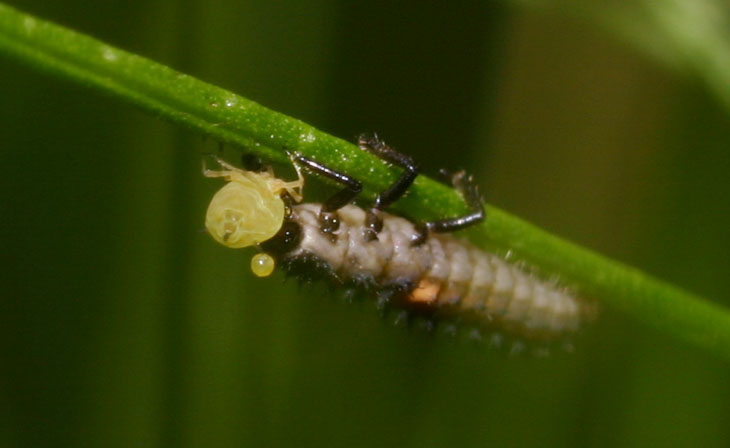





















































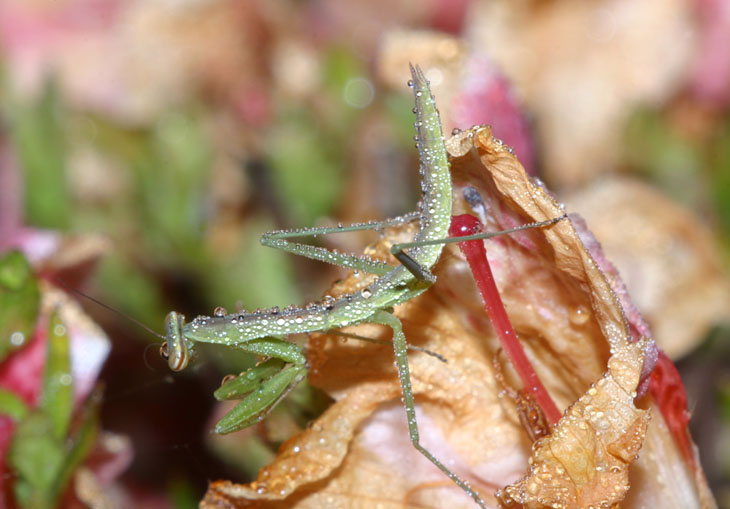
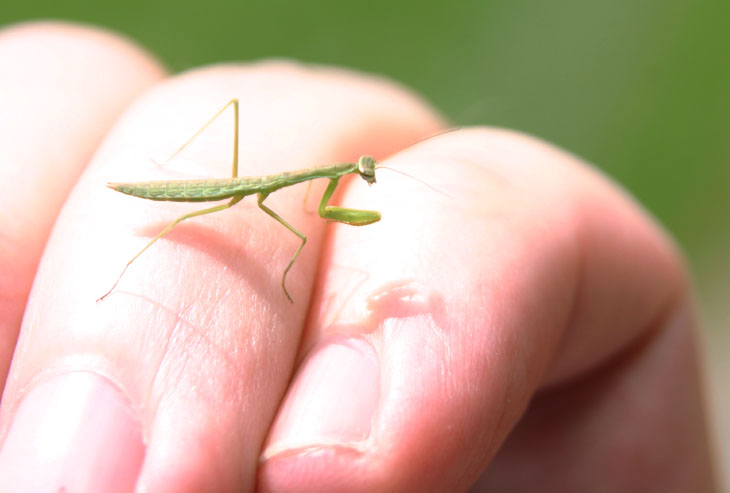
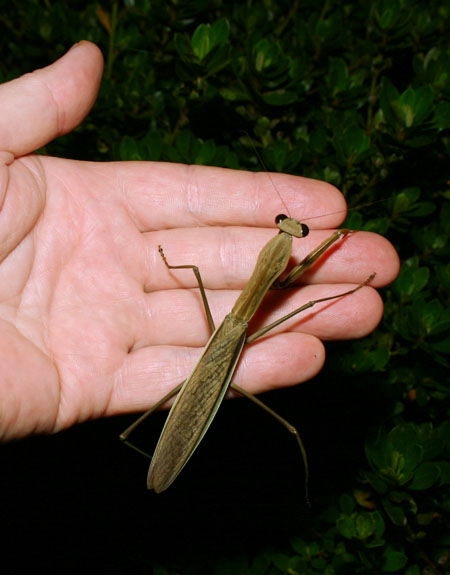 So a few minutes ago (it’s 10:30 pm as I type this,) she reappeared, and I wasted no time in taking this shot, strictly for comparison. The Girlfriend, who sees them only about 10% of the times that I do, is always surprised to see how they’ve grown, but these images display it more distinctly I think.
So a few minutes ago (it’s 10:30 pm as I type this,) she reappeared, and I wasted no time in taking this shot, strictly for comparison. The Girlfriend, who sees them only about 10% of the times that I do, is always surprised to see how they’ve grown, but these images display it more distinctly I think.

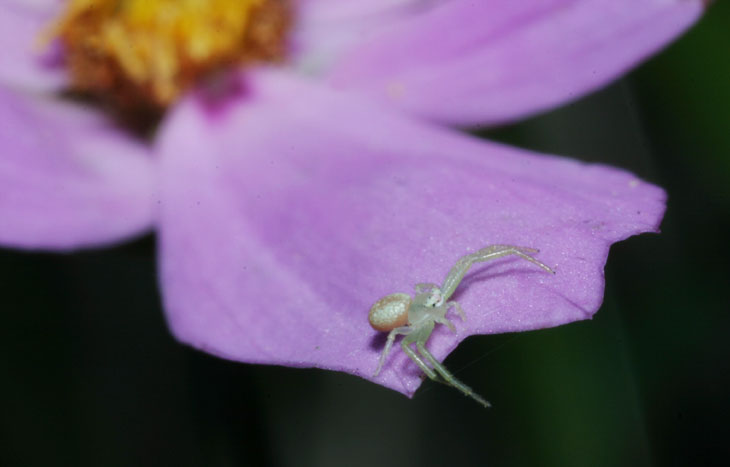
 The next time the moth bumbled into the grass, it never rose again; the spider moved with lightning speed and nailed it where it had touched down. Keep in mind that the moth was moving as erratically as they ever do, and was in and out of the light’s beam constantly. I’m so used to arthropods that have limited distance vision that I forget about the ones that don’t, so the utter efficiency of this capture was stunning to behold.
The next time the moth bumbled into the grass, it never rose again; the spider moved with lightning speed and nailed it where it had touched down. Keep in mind that the moth was moving as erratically as they ever do, and was in and out of the light’s beam constantly. I’m so used to arthropods that have limited distance vision that I forget about the ones that don’t, so the utter efficiency of this capture was stunning to behold.
 Once again this year, the inchworm stage of the wavy-lined emerald moth (Synchlora aerata) has made its appearance on the flowers in the yard, and when I say “appearance,” I mean “trying hard not to.” This species camouflages itself with flower petals plucked from its host plant, making it able to sit distinctly in the open and munch on the flowers without attracting attention. The key to spotting them, aside from peering very closely at every flower that one comes across, is that they often use the outer petals for their camo, so the nice geometry of rim petal color and interior reproductive organs is marred – there are petals ‘growing’ from the center of the bloom. Also, not surprisingly, the plucked fragments don’t last very long and wilt, and may display a noticeable difference between the fresh healthy flower bloom and the browning cover of the inchworm. Since this species of flower has an exceptionally brief period in bloom, this difference may last only a day or so before the host looks much like the camouflaged larva.
Once again this year, the inchworm stage of the wavy-lined emerald moth (Synchlora aerata) has made its appearance on the flowers in the yard, and when I say “appearance,” I mean “trying hard not to.” This species camouflages itself with flower petals plucked from its host plant, making it able to sit distinctly in the open and munch on the flowers without attracting attention. The key to spotting them, aside from peering very closely at every flower that one comes across, is that they often use the outer petals for their camo, so the nice geometry of rim petal color and interior reproductive organs is marred – there are petals ‘growing’ from the center of the bloom. Also, not surprisingly, the plucked fragments don’t last very long and wilt, and may display a noticeable difference between the fresh healthy flower bloom and the browning cover of the inchworm. Since this species of flower has an exceptionally brief period in bloom, this difference may last only a day or so before the host looks much like the camouflaged larva.



